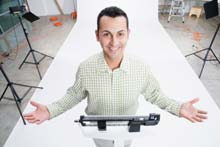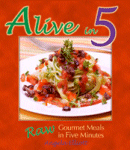Is "The Biggest Loser" Risking Contestants' Lives?
Dangerous Weight-Loss Techniques Revealed
by www.SixWise.com
The 10 million viewers who tune in to watch “The Biggest Loser” each Wednesday night along with the 200,000 auditioning contestants are telling of America’s obsession with weight loss. A special upcoming reunion shows just how far contestants are willing to go to come out as the winner on the show.
|

What length are “The Biggest Loser” contestants will to go to in order to lose weight?
|
According to a New York Times article, the winner from the show’s first season, Ryan C. Benson, won’t be making appearance on the show for two reasons: he’s put back on all of the weight he lost and the show has shunned him after he admitted to resorting to extreme weight loss measures while on the show, consisting of severe fasting and dehydrating his body to the point he was urinating blood.
Doctors and nutritionists outside of the show are concerned about the dangerous, quick weight-loss methods contestants use on the show such as severe calorie restriction, hours and hours of strenuous exercise a day and self-induced dehydration.
New contestants coming on the show are heavier and more out of shape than previous contestants, spurring concerns among the medical community regarding medical problems resulting from rapid weight loss. This can include a weakening of the heart muscle, irregular heartbeat and dangerous reductions in potassium and electrolytes.
Other former contestants on the show divulged the extreme measures they took to lose weight like drinking minimal amounts of water 24 hours leading up to a weigh-in and working out in layers upon layers of clothing.
Several contestants gained back at least 20 percent of their weight after the show just by drinking water.
Trainers used on the show said that each new contestant is required to go through a medical checkup and has to sign a medical consent form certifying they believe themselves to be in excellent physical, emotional, psychological and mental health. They face disqualification if they are found engaging in unsafe practices like self-induced dehydration or use of drugs or diuretics.
Three Dangerous Diet Techniques You Should NOT Try at Home
The practice of fasting, abstaining from food and in many cases drinks, has been around for centuries as a religious practice used as an act of devotion. Recently, it has been popularized by stars like Beyonce, who followed the Master Cleanse for quick, short-term weight loss, and shelves of do-it-yourself detox books in popular bookstore chains. The Master Cleanse consists of living off of nothing but a mixture of lemon juice mixed with maple syrup, water and cayenne pepper, salt water and a laxative tea for 10 days.
There are different forms of fasting, which range from eating little to no food to detox diets that promise to cleanse and remove toxins from your body. Other plans restrict all solid foods and instruct followers to survive solely on low-calorie beverages for days at a time, including some kind of laxative concoction. The goal is at the end of the diet you will feel refreshed and energized. Research shows, however, that our bodies are constructed with built-in detoxification systems, specifically the kidneys, liver, lungs, colon and skin, that work on their own removing toxins from the body.
Fasting, when done safely and under the guidance of a holistic health care practitioner, may impart some benefits to your health. However, it should not be used solely as a weight loss technique, especially if you do not know how to fast safely.
Even advocates of fasting for medical conditions agree that fasting is an unhealthy weight-loss tool that if practiced over an extended period of time, anywhere over three days to a month or a repeated number of times throughout the year, can result in unhealthy side effects from the minor:
-
Dizziness
-
Headaches
-
Low blood sugar
-
Muscle aches
-
Weakness
-
Fatigue
To the more serious:
-
Vitamin deficiencies
-
Muscle breakdown
-
A weakened immune system
-
Blood-sugar problems
-
Frequent liquid bowel movements
-
Anemia
-
Impairment of liver function
-
Kidney stones
-
Mineral imbalances
-
Diarrhea
-
Laxative concoctions during a fast, there is an increased risk of fluid imbalance and dehydration
-
Deaths due to prolonged fasting have occurred
“Long-term fasts lead to muscle breakdown and a shortage of many needed nutrients,” says Lona Sandon, a Dallas dietitian and spokesperson for the American Dietetic Association in an MSNBC article. Depriving the body of the vitamins and minerals we get from food can "actually weaken the body’s ability to fight infections and inflammation,” she says.
Experts warn that certain groups of people should not engage in any type of fasting. These groups include:
One of the biggest downsides to fasting for weight-loss is that the initial weight lost during the diet is considered “water weight” -- not fat. Water weightusually returns once you go off the diet, sometimes along with a few extra pounds due to your metabolism slowing down, making it easier to put weight back on.
Overuse of Laxatives Can Turn into Laxative Abuse
Several detox diets include some sort of laxative mixture as part of the daily regime. The problem with laxatives happens when they are used excessively, causing serious medical conditions such as dehydration.
Some people resort to the use of laxatives alone as a weight-loss technique and in some cases take large amounts, which can lead to laxative abuse. The vicious cycle of taking laxatives and experiencing the effects of losing “water weight” early on and then continuing to take them for continued weight-loss ensues.
Laxative abuse takes a heavy toll on the body and results in the following serious health conditions:
-
Severe dehydration and electrolyte imbalances
-
Severe constipation or chronic diarrhea
-
Edema (swelling)
-
Blood in the stools which may cause anemia
-
Laxative dependency
-
Increased risk of colon cancer
Dehydration from laxative abuse goes far beyond the feelings of being thirsty, and long-term episodes of dehydration can start to attack your kidneys and, in serious cases when left untreated, can result in seizures, permanent brain damage or death.
When Exercise Becomes an Obsession
Some people get obsessive in their quest for a thinner body and with that go overboard with exercising. Recently there has been a rise in the number of people becoming addicted to extreme exercise and defining themselves through their taxing exercise routines and putting their health at risk, especially if they are drastically cutting back on their food intake at the same time. For example, female exercisers who engage in overexercise and severe diets can experience loss of menstruation cycles and ovulation and at put themselves at risk of stress fractures and osteoporosis.
Once a person becomes a compulsive exerciser, nothing will stop them from completing their exercise regime, including sickness, injury, exhaustion or damage to their health.
While exercise disorders are most apparent in people with eating disorders such as anorexia nervosa and bulimia nervosa, it can manifest in individuals without these disorders and in those that are exercising just for the sake of exercising.
There’s no denying regular exercise can benefit your health and boost your immune system; it’s when you exercise daily to the point of collapse that you are actually hindering your immune system.
The health effects of overexercising are both physical and emotional:
-
Injury
-
Sickness
-
Fatigue
-
Teens have difficulty sleeping
-
Relationships and social life are impacted by taking a back seat to exercising
-
Irritability
-
Can trigger eating disorders like bulimia
Nurture Your Body With Healthy Foods
You can lose and maintain your weight loss without taking drastic measures and putting your health at risk by making a few simple and safe changes to your lifestyle. By making simple life changes and establishing a gentle, yet effective, exercise program for yourself, you’ll be on your way to feeling and looking better.
Start out the New Year with these three healthy eating habits:
1. Give Your Pantry and Fridge a Healthy, New Look
Since you are what you eat, why not do your body good by providing it with good, healthy foods. Go through your pantry and fridge and look at how many processed foods make up your daily diet. Then start incorporating fresh, whole, disease-fighting foods into your diet such as vegetables, fruits, whole grains and beans. The American Institute for Cancer Research (AICR) recommends getting five or more daily servings of fruit and vegetables and seven or more servings of whole grains and beans.
As you switch over to more fresh foods, we highly recommend you take advantage of the healthy and absolutely delicious recipes in the book “Alive in 5”: Raw Gourmet Meals in Five Minutes. When prepared with locally grown ingredients from a source you trust, these are among some of the safest meals you can eat. Because you’ll know what you’re eating is so good for your body and mind, it’ll likely help improve your mood too, making it less likely that you’ll feel like overeating later.
|
Discover Healthy Recipes
in "Alive in 5!"

Alive in 5: Raw Gourmet Meals in Five Minutes is a book packed with delicious raw-food recipes that you can make in a snap. These unique dishes, created by acclaimed raw chef Angela Elliott, create an inspiring guide to delicious and healthy living.

Order Alive in 5: Raw Gourmet Meals in Minutes Now!
|
2. Know Healthy Portion Sizes
Once you’ve stocked your cabinets and fridge with healthy foods, the next step is educating yourself on appropriate portion sizes. Research has shown that Americans underestimate how many calories they consume each day by 25 percent. Living life on the go, constantly multi-tasking, quick meals at drive-thrus with inflated serving sizes and eating in front of the computer at work or in front of the television at home distracts us from paying attention to our portion sizes.
According to the AICR, vegetables, fruits, beans and whole grains can take up to two-thirds of your plate. For samples of appropriate portion sizes you can print out the USDA’s portion-size guidelines and post it on your refrigerator.
Here are 10 simple tips to get you back on track to good portion sizes in your home, at restaurants and at the grocery store:
At home:
Read the serving sizes on the food package labels in your house. Use smaller dishes for meals. Divide appropriate food portions among plates instead of serving dinner family style. Allow a full sensation to set in before getting up to get seconds. Divvy up your leftovers in small portion-sized containers right after mealtime. Never eat snacks like pretzels or chips out of the bag or ice-cream directly from the carton.
While eating out:
-
Request half-portions and if that’s not possible, ask the wait staff for a doggie bag so you can pack half to go. Some of the super-sized portions served at restaurants can provide you with lunch for the next two days.
-
Approach buffet tables mindfully -- Carefully scope out the food selection on the buffet table and pick out only the foods that look appealing to you. With each food item that you select, keep the portion size guide in your head.
-
If you order a dessert, share it.
When doing your grocery shopping:
-
Use caution when buying “mini-snacks” -- Many times people actually end up eating more calories due to the small size packages of tiny crackers, cookies and pretzels.
-
Buy foods that are packaged as individual serving sizes or buy in bulk and package the food into an individual serving size yourself.
-
For ice-cream treats, don’t buy a carton, chose individual ice-cream bars.
|
MySheaNetics.com:
Your Pathway to Well-Being

SheaNetics from MySheaNetics.com realizes your goal is to find total health and fulfillment that is life lasting. This can be achieved by creating harmony in body, mind and self. SheaNetics gives you the practical tools to get into shape and kick it to ever higher levels.
Each nearly one hour workout is a new blend of the-best-of-the-best from Yoga, Pilates, Tai Chi, Martial Arts, Gyro-Kinesis, Dance and MORE -- guiding you through unique sequences of movements that strengthen, sculpt, build core and increase flexibility!
Separately (Each) List Price ($95.95)
Your Special Price Just $59.00!
NEARLY A 30% SAVINGS + Free Shipping
|
3. Follow an Exercise Program that Addresses Your Mind and Body
Because your body and mind are so closely linked, a weight loss program that only focuses on your physical being will miss out on the incredibly important mental and emotional aspects of health.
In fact, if you're looking to achieve long-term health improvements, behavior changes and self-acceptance are more effective than dieting any day of the week, according to a two-year study published in the June 2005 issue of the Journal of the American Dietetic Association.
To start making positive behavioral changes, focus on making small changes in your lifestyle, not on losing weight. For instance, rather than thinking, "I have to lose 30 pounds," think, "Today I'm going to take a pass on the bread and butter and go for a walk after dinner."
By adding just one or two healthy behaviors to your routine each day, such as swapping your soda for a glass of mineral water, you’re subtly changing your old, weight-sabotaging habits into new healthier ones.
You will also want to include a form of physical activity that addresses your mind-body connection, and we are extremely excited to introduce for you a one-of-a-kind fitness program called SheaNetics from MySheaNetics.com. It is an ideal addition to your weight loss journey.
SheaNetics, founded by fitness expert Shea Vaughn, blends ancient and contemporary movements with eastern philosophy, creating a stylized approach to fitness designed to improve the quality of today’s western living.
Shea spent years researching and teaching in the commercial fitness industry and has a first-hand understanding of the physical, mental and emotional benefits of living a life of exercise.
The program is unlike any other fitness program in that it offers a source of strength and inspiration to support your health journey.
We encourage you to check out Shea’s new 6-Disc DVD/CD workout set to “get started on your pathway to well-being!”
This groundbreaking DVD collection contains:
-
3 core-building, mind-boosting, complete body-charging workouts!
-
As a FREE GIFT you will also receive 3 empowering, “original music” CDs specially composed to power up your journey!
-
You also receive the SheaNetics Booklet with The Five Living Principles -- a life-changing guide to finding Your Pathway to Well-Being!
Once you’ve jumped right in to SheaNetics, the true mind-body fitness program, you will begin to open your mind to healthy lifestyle habits. With each step you take on this journey, you’ll find it easier to make the lifestyle changes that will ultimately help you reach not only your ideal weight but also physical and mental well-being.
Recommended Reading
Are You Dehydrated? Many People Are and Don't Even Know It!
Does Fasting Contribute to a Healthy Lifestyle or Not?
The Best Weight Loss Diets: Which Ones Work and Which are a Waste of Money? (Plus 16 Key Tips to Help Nearly Everyone Slim Down)
Sources
The New York Times November 24, 2009
edtreatmentcenters.com
WebMD
MSNBC.com
Health and Medical Articles
Eatingdisorder.org
Healthyplace.com
The Diet Channel